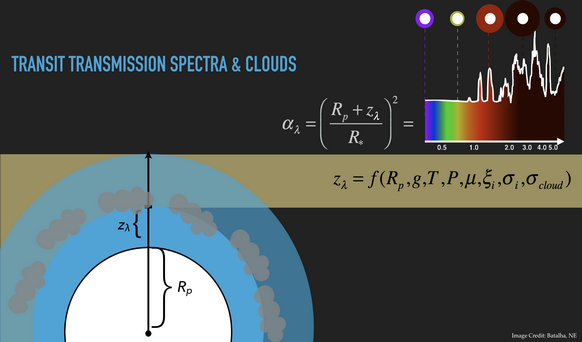Is Exoplanet Atmosphere Detectable? Multiband Transit Depths Hints the Haze Dominant Atmosphere of KELT-19Ab
The planetary atmosphere outside the solar system can be revealed by measuring bandpass-dependent transit depths. This study is performed by Ji-Feng Liu and his PhD student Fan Yang from the National Astronomical Observatories of the Chinese Academy of Sciences (NAOC).
By comparing the high precision transit light curves from the Transit Exoplanet Survey Satellite (TESS) and other telescopes, they found evidence of a haze dominant atmosphere exoplanet KELT-19Ab. This work was published on The Astronomical Journal in Feb. 2022.

Fig.1: The transmission spectra resolve the planet atmosphere. (Credit: Batalha, NE)
When the planet comes across its host star, the transit depth would leave imprints of its features which leads to the detection of more than 3000 exoplanets. This flux decrease would be different due to the transmission variety of certain compositions. The atmospheric features are thereby resolvable through analyzing the so-called transmission spectra.
The recently commissioned space telescope TESS offers high-quality time-domain images for nearby exoplanets. NAOC-Caltech research team concentrates on obtaining precise light curves from the raw TESS data. They develop an independent data reduction pipeline, particularly effective in deblending the nearby contaminated flux which is very important for TESS.
The other effects possibly causing transit depths difference are carefully checked, including e.g., sampling rate, baseline modeling, fitting prior modification, stellar variability. The need in improving limb darkening leads to a novel, iterative method, using an empirical Bayesian approach. This work is published earlier in The Astronomical Journal.
"The transit depths in different bands reveal the existence of the KELT-19Ab atmosphere," said Fan Yang from NAOC who is the first author of the paper. "We expect more opportunity to gain insight into the planet atmosphere, with new powerful telescopes e.g., JWST, LSST, Sitian."
The exoplanet atmosphere has been rapidly speeding up due to the successful joint analysis of ground-based telescopes and space telescope of Hubble, TESS, in the recent decade. Sitian telescope array proposed by Chinese astronomers aims at producing high precision photometry monitoring the sky. The exceptional optical design and key site planning at Lenghu would well ensure the precision requirement for exoplanet transit research (details in the recently accepted study in Research in Astronomy and Astrophysics; open-source site arxiv.org).
"Sitian will detect and analyze up to 25,000 planets in ten years. This fivefold planet sample size and the interesting targets involved will significantly improve our knowledge of the planet and its atmosphere," said Fan Yang.

Fig.2: KELT-19Ab transit depths in different bandpasses, indicating a haze dominant atmosphere as the best explanation for the observation. (Credit: Yang et al. 2022)
This paper can be accessed at https://iopscience.iop.org/article/10.3847/1538-3881/ac3b4e/pdf